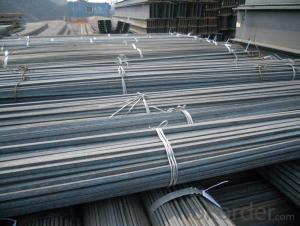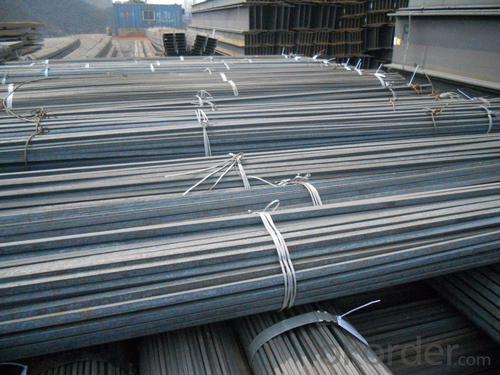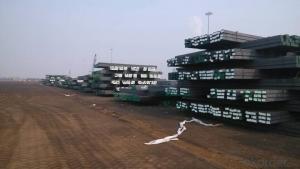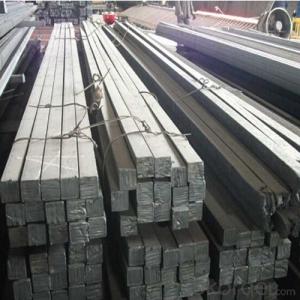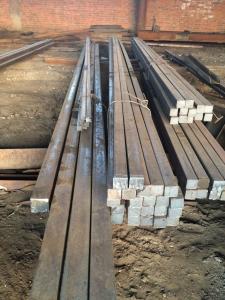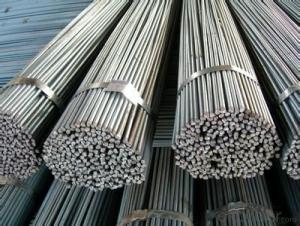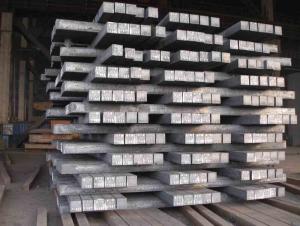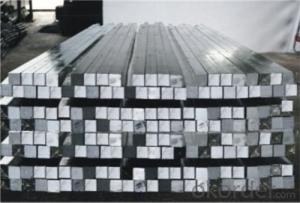Hot Rolled Square Steel Bar Material Q235
- Loading Port:
- Qingdao
- Payment Terms:
- TT or LC
- Min Order Qty:
- 25 m.t.
- Supply Capability:
- 3000 m.t./month
OKorder Service Pledge
OKorder Financial Service
You Might Also Like
Product Description:
OKorder is offering Hot Rolled Square Steel Bar at great prices with worldwide shipping. Our supplier is a world-class manufacturer of steel, with our products utilized the world over. OKorder annually supplies products to European, North American and Asian markets. We provide quotations within 24 hours of receiving an inquiry and guarantee competitive prices.
Product Applications:
The Square Steel is normally used as structure steel.
Row material for other structure steel like steel angles, channels, I-beams, H-beams, etc…
Product Advantages:
OKorder's Hot Rolled Square Steel Bar Material Q235 are durable, strong, and resist corrosion.
Main Product Features:
· Premium quality
· Prompt delivery & seaworthy packing (30 days after receiving deposit)
· Corrosion resistance
· Can be recycled and reused
· Mill test certification
· Professional Service
· Competitive pricing
Product Specifications:
Length of a side(mm) | Theoretical weight(kg/m) | Length of a side(mm) | Theoretical weight(kg/m) |
6 | 0.283 | 32 | 8.04 |
7 | 0.385 | 33 | 8.55 |
8 | 0.502 | 34 | 9.07 |
9 | 0.636 | 35 | 9.62 |
10 | 0.785 | 36 | 10.17 |
11 | 0.950 | 38 | 11.24 |
12 | 1.13 | 40 | 12.56 |
13 | 1.33 | 42 | 13.85 |
14 | 1.54 | 45 | 15.90 |
15 | 1.77 | 48 | 18.09 |
16 | 2.01 | 50 | 19.63 |
17 | 2.27 | 53 | 22.05 |
18 | 2.54 | 55 | 23.6 |
19 | 2.82 | 56 | 24.61 |
20 | 3.14 | 58 | 26.4 |
21 | 3.46 | 60 | 28.26 |
22 | 3.80 | 63 | 31.16 |
23 | 4.15 | 65 | 33.17 |
24 | 4.52 | 68 | 36.3 |
25 | 4.91 | 70 | 38.49 |
26 | 5.30 | 75 | 44.16 |
27 | 5.72 | 80 | 50.24 |
28 | 6.15 | 85 | 56.72 |
29 | 6.60 | 90 | 63.59 |
30 | 7.06 | 95 | 70.85 |
31 | 7.54 | 100 | 78.50 |
Notes:
1, The theoretical weights in the list, base on the density of 7.85 g/cm3.
2, The numbers with mean that they are not regulars or we don’t offer them.
-List 2. The allowed tolerance of Square Steel:
Length of a side(mm) | Allowed Tolerance | ||
Group1 | Group2 | Group3 | |
5.5~7 | ±0.20 | ±0.30 | ±0.40 |
7~20 | ±0.25 | ±0.35 | ±0.40 |
20~30 | ±0.30 | ±0.40 | ±0.50 |
30~50 | ±0.40 | ±0.50 | ±0.60 |
60~80 | ±0.60 | ±0.70 | ±0.80 |
80~110 | ±0.90 | ±1.0 | ±1.1 |
110~150 | ±1.2 | ±1.3 | ±1.1 |
150~190 | ―― | ―― | ±2.0 |
190~250 | ―― | ―― | ±2.5 |
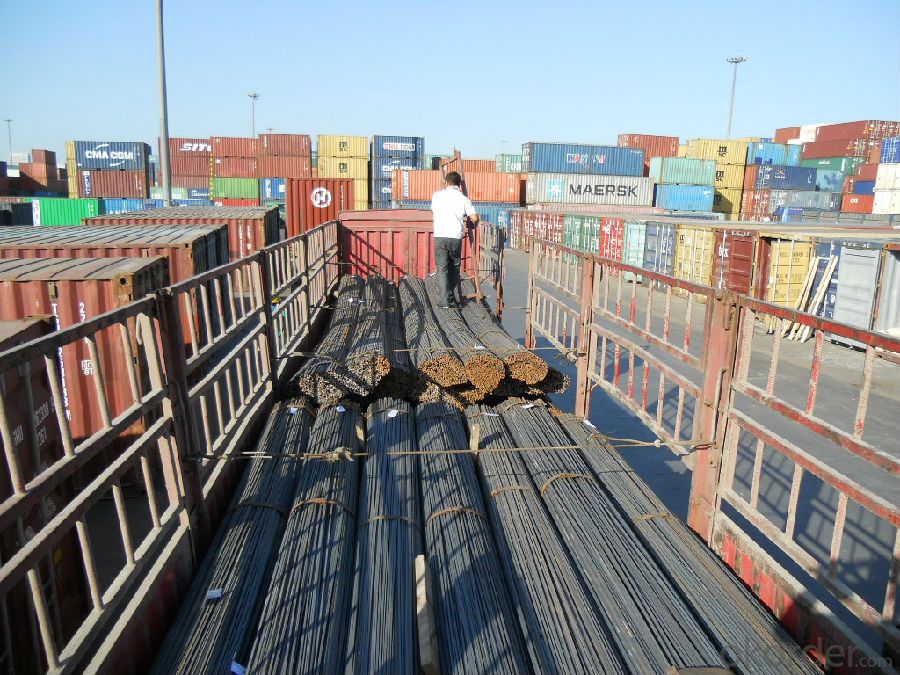
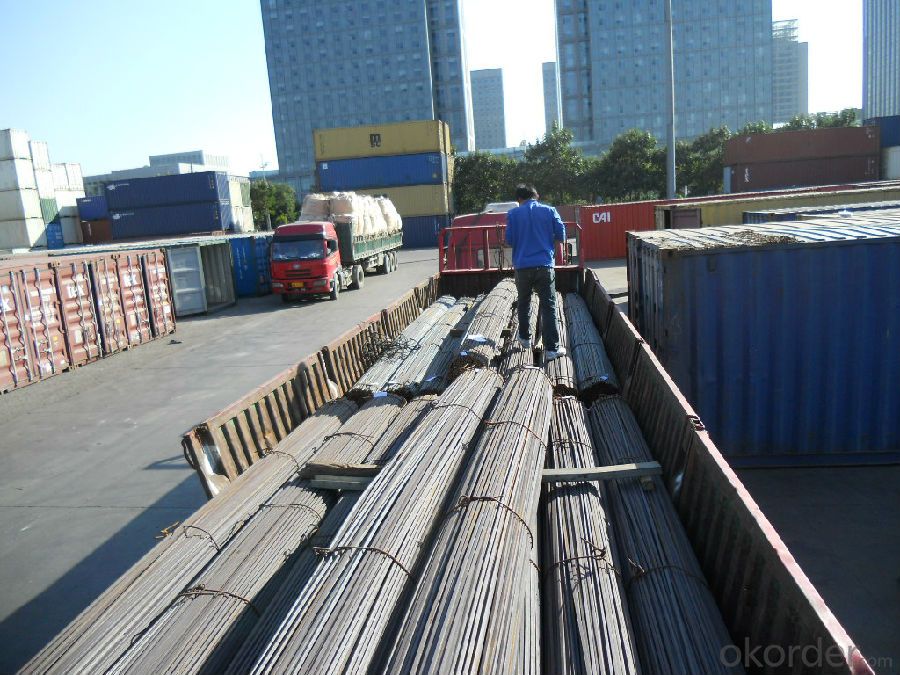
Payment:
-Invoicing on theoretical weight or actual weight as customer’s request.
-Regular terms of payment:
1, 30% payment in advance, the remaining balance (70% payment) against the copy of B/L.
2, 30% payment in advance, the remaining balance (70% L/C) against the copy of B/L.
3, Negotiable.
FAQ:
Q1: Why buy Materials & Equipment from OKorder.com?
A1: All products offered byOKorder.com are carefully selected from China's most reliable manufacturing enterprises. Through its ISO certifications, OKorder.com adheres to the highest standards and a commitment to supply chain safety and customer satisfaction.
Q2: How do we guarantee the quality of our products?
A2: We have established an advanced quality management system which conducts strict quality tests at every step, from raw materials to the final product. At the same time, we provide extensive follow-up service assurances as required.
Q3: How soon can we receive the product after purchase?
A3: Within three days of placing an order, we will begin production. The specific shipping date is dependent upon international and government factors, but is typically 7 to 10 workdays.
- Q: What are the different ways to hold a steel square when making measurements?
- When making measurements with a steel square, there are various ways to hold it. The most commonly used approach involves grasping it by the handle, positioning the blade perpendicular to the surface being measured. This allows for easy alignment and stability during measurements. Another option is to place the steel square on the surface being measured and firmly press it against the edge or corner. This technique ensures accurate measurements by securely holding the square in place. Alternatively, one can hold the steel square by gripping it with both hands, with the blade facing outward. This method offers enhanced control and stability, particularly when making precise measurements or marking lines. Some professionals opt for a technique known as "finger grip," where the steel square is held along the blade using the fingers. This provides greater flexibility and mobility when measuring in tight or hard-to-reach areas. Ultimately, the choice of how to hold a steel square for measurements depends on personal preference and the specific task at hand. It is crucial to find a grip that feels comfortable and secure to guarantee accurate and reliable measurements.
- Q: What are the common uses of a steel square in welding?
- A steel square is commonly used in welding for measuring and marking angles, ensuring accurate and precise cuts, and checking the alignment of welded joints. It is also used for laying out or squaring parts before welding, verifying perpendicularity, and determining the squareness of corners.
- Q: How do you use a steel square to measure board diagonals at different angles?
- In order to measure board diagonals at various angles using a steel square, it is necessary to follow these instructions: 1. Prioritize cleanliness and ensure that the steel square is free from dirt or debris that may affect its accuracy. 2. Position the steel square on the board, aligning one of its edges with the board's edge. 3. Confirm that the square is securely placed and does not move or shift during the measurement procedure. 4. Determine the diagonal line that requires measurement. Depending on the angle of interest, this could be a 45-degree angle or any other specific angle. 5. Align the angle or measurement mark on the square with the board's edge, ensuring that it is perpendicular to the edge. 6. Extend the measurement from the marked angle across the board until it reaches the opposite edge. 7. Take note of the measurement or mark the endpoint of the diagonal line for future reference. 8. Repeat the above steps to measure any other diagonals or angles desired. It is crucial to maintain precision in your measurements and ensure that the steel square remains firmly in place throughout the process. By following these steps, you can effectively utilize a steel square to measure board diagonals at various angles.
- Q: How does a steel square assist in determining the correct angle for a cove cut?
- When trying to achieve a cove cut, it is crucial to have the appropriate angle for the desired shape and fit. This is where a steel square comes in handy. Serving as a precise and accurate measurement tool, a steel square aids in determining the correct angle. Typically featuring a 90-degree angle, the steel square acts as a reference point. By aligning it with the material's edge that needs to be cut, you can establish a perpendicular line. This perpendicular line is then used to ascertain the correct angle for the cove cut. To find the correct angle, measure the distance from the perpendicular line to the desired endpoint of the cove cut. This measurement will provide the angle necessary to achieve the desired shape and fit. Furthermore, a steel square often includes other angle markings like 45 degrees. These markings can be utilized to create various types of cove cuts or to verify the accuracy of the measurement. Overall, a steel square is a reliable and precise measurement reference that assists in determining the correct angle for a cove cut. By ensuring accuracy and quality, it guarantees the desired outcome of the cut.
- Q: The difference between galvanized square and galvanized steel
- There is a difference in the quality of classification and can be processed into cold and hot dip galvanized pipe, galvanized pipe, galvanized pipe and galvanized belt can not be made, because of its wall thickness is thin, so the price will take the price dip galvanized pipe is much higher than galvanized pipe.
- Q: How do you use a steel square to determine board thickness?
- To use a steel square to determine board thickness, you can follow these steps: 1. Place the steel square on a flat surface, ensuring it is aligned properly. 2. Take the board that you want to measure and place it against the inside edge of the steel square. 3. Slide the board along the length of the steel square until it fits snugly between the square's inside edge and the surface it is resting on. Make sure the board is perpendicular to the square. 4. Look at the markings on the steel square. The inside edge of the square will have a series of measurements, usually in inches and fractions of an inch. 5. Find the line or measurement that aligns with the edge of the board. This will indicate the thickness of the board. 6. Read the measurement on the steel square. It will tell you the exact thickness of the board at the point where it is resting against the square. 7. Take note of the measurement for your reference. You can use this information for any further woodworking or construction tasks that require precise board thickness. Remember to handle the steel square and board with care to ensure accuracy in your measurements.
- Q: How do you use a steel square to measure board lengths at different angles?
- To use a steel square to measure board lengths at different angles, you would start by placing the square's long side (blade) against the edge of the board. Next, rotate the square until the desired angle aligns with the edge of the board. Once aligned, mark the board along the shorter side (tongue) of the square. Finally, measure the distance from the marked point to the end of the board to determine the length at the specific angle.
- Q: Can a steel square be used for baseboard installation?
- Yes, a steel square can be used for baseboard installation. A steel square, also known as a framing square or a carpenter's square, is a versatile tool that is commonly used in woodworking and construction projects. It is a durable and sturdy tool made of steel, with a 90-degree angle and a ruler along the edge. When it comes to baseboard installation, a steel square can be extremely helpful. It can be used to ensure accurate and precise cuts on the baseboard material, as well as to mark and measure angles for corners and joints. The 90-degree angle of the steel square is particularly useful for marking and cutting baseboards that need to fit perfectly into corners or against walls. Additionally, a steel square can be used to check the levelness and squareness of the baseboards during the installation process. By placing the square against the baseboard and the wall, you can easily determine if the baseboard is straight and aligned correctly. Overall, while there are other tools available for baseboard installation, a steel square is a reliable and versatile option that can be used effectively in this task.
- Q: Can a steel square be used for tile accent layout?
- Yes, a steel square can be used for tile accent layout. A steel square, also known as a framing square or carpenter's square, is a versatile tool that can be used for various layout and measurement tasks in construction, including tile work. Its L-shaped design and right angles allow for precise and accurate measurements, making it suitable for creating straight lines and angles needed for tile accent layout. However, it's important to note that a steel square should be used in conjunction with other tools, such as a level and chalk line, to ensure the tiles are positioned correctly and evenly.
- Q: Can a steel square be used for checking the alignment of a fence?
- A fence's alignment can indeed be checked using a steel square. This versatile tool, also referred to as a framing square or carpenter's square, serves multiple purposes in the field of carpentry and construction. It comprises a lengthy blade and a shorter tongue, creating a right angle and featuring measurement markings along both sides. In order to verify the alignment of a fence, a steel square can be utilized to guarantee that the posts and rails are appropriately perpendicular to one another. This is crucial for upholding the fence's structural integrity and stability. To begin, position the steel square against one of the fence posts, ensuring that the blade aligns with the post while the tongue extends along the rail. Verify whether the square is flush against both the post and rail. If it is not, proceed to make adjustments to align them properly. Subsequently, employ a level to determine if the square is truly vertical. If the bubble in the level is centered, it indicates that the fence post is plumb. If it is not centered, make the necessary adjustments to the post until it achieves perfect verticality. Repeat this procedure for each fence post and rail to guarantee that the entire fence maintains proper alignment. Utilizing a steel square can assist you in achieving a fence that is straight and level, thereby enhancing both its functionality and aesthetic appeal.
Send your message to us
Hot Rolled Square Steel Bar Material Q235
- Loading Port:
- Qingdao
- Payment Terms:
- TT or LC
- Min Order Qty:
- 25 m.t.
- Supply Capability:
- 3000 m.t./month
OKorder Service Pledge
OKorder Financial Service
Similar products
Hot products
Hot Searches
Related keywords
